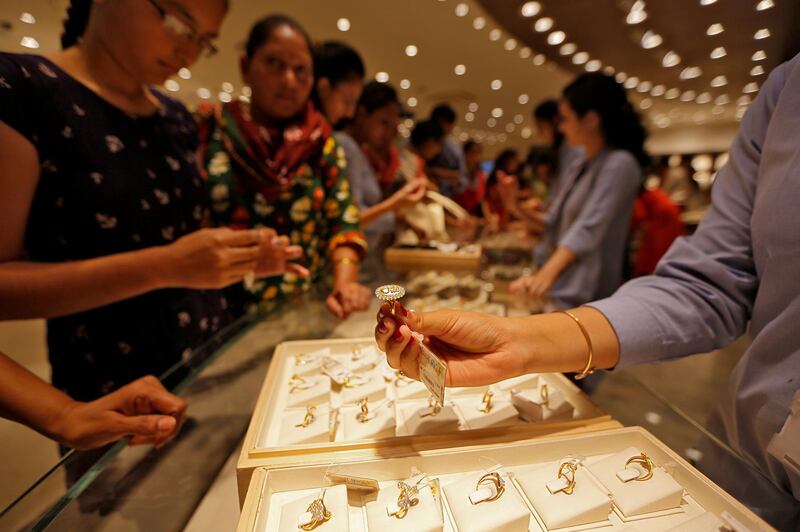Business should be brisk for Mumbai jeweller Anil Jain. With the wedding season under way, it is a peak time for buying gold in India. But his sales are half of what they were last year. "The prices have increased and the whole economy is not performing well," says Mr Jain. "It's subdued."
In India, which is the world’s second-largest consumer of gold after China, the precious metal has deep cultural and traditional roots. But that has not stopped it from losing some of its shine in recent months amid a challenging backdrop.
The World Gold Council forecasts the country's gold demand this year will fall to its lowest level in three years. Demand for the yellow metal in the three months to the end of September was down 32 per cent to 123.9 tonnes, compared to the overall third quarter demand for 2018, its data on India shows.
Somasundaram PR, managing director India at WGC, says this is due to "weak consumer sentiment and high prices".
Seen as a safe haven, gold prices have risen amid concerns about the global economy. Prices in India are hovering sky-high at around 39,000 rupees (Dh1,996) in India, up more than 20 per cent compared to a year ago.
On top of this, the WGC cites heavy rains during this year's monsoon season as a factor in demand weakness. The rains wiped out crops, meaning many farmers took a hit to their earnings, leading to a decline in the appetite for gold among the rural population.
India received its highest levels of monsoon rainfall in 25 years this season, which started in June and lasted four months. Most of India's gold demand comes from rural areas, where the majority of the country's population still reside, and where people often store their wealth in gold as an alternative to banks.
“Gold prices increased sharply in a short time frame, thereby deterring consumers,” says Arvind Sahay, chairman of the India Gold Policy Centre at the Indian Institute of Management Ahmedabad, which conducts research on the country’s gold industry. “The slowdown in economic activity has added to the weak sentiment.”
This is despite the fact that India has been celebrating festivals, in particular Diwali last month, which is a popular time to purchase gold. India's wedding season has also begun, which usually leads to a gold-buying rush in the country, with jewellery considered essential to lavish marriage celebrations that span across several days. The yellow metal is believed to bring good fortune and is a way to show off wealth, and also an essential part of the dowry system, which is still widely practied in the country despite having been banned.
Ketan Chokshi of the jewellery brand Narayan Jewellers, based in Vadodara in the western Indian state of Gujarat, says “India still has a ritual value for buying gold”.
“It’s considered to be auspicious to buy gold and especially during weddings in India,” he says. “You can’t imagine an Indian wedding without gold.”
He says “people still believe it has an investment value” and want to buy the precious metal. But consumers are reducing the value of their purchases in the current economic climate, Mr Chokshi says.
India’s gross domestic product growth fell to a more than six-year low of 5 per cent in the April to June quarter, and with the latest quarterly data due to be released later this month, analysts are predicting that growth may have fallen even more – which does not bode well for gold demand. “We don’t think the market is going to come back to normal for a least another three to six months,” says Mr Chokshi.
Mr Sahay believes the downturn could be even more prolonged.
“As the prices are going to remain firm [for a] longer period it might take a year or two when consumers get comfortable,” he says.
Given the high prices and weak sentiment surrounding the economy, analysts say that many people are opting to sell off their gold at this point in time.
“There’s been some selling in gold which is reflected in the increased supply of scrap gold in domestic markets,” says Rahul Agarwal, a director at Wealth Discovery, a financial services company based in New Delhi. “Individuals who had bought gold for investment purposes have indeed used the recent spike in gold prices to book some profits.”
The amount of scrap gold entering supply in India increased by 59 per cent to 36.5 tonnes during the third quarter, WGC figures show. And with India facing liquidity issues due to challenges in the non-banking financial sector, companies that provide loans against gold are benefiting as people use their stash of the precious metal to secure cash loans.
"Most gold loan customers are marginal borrowers, unserved by traditional banking," says Jayesh Kumar, chief economist at Manappuram Finance, a gold loan provider in Kerala. "Their demand for gold loan is primarily driven by the need for credit. In our recently announced result for the June to September quarter, we reported a 14 per cent sequential growth in the gold loan portfolio."
Another trend is that demand for silver seems to be gaining popularity in India. Data from India’s trade ministry reveals that imports of silver into the country surged by 72 per cent in August over the same month the previous year to 543.21 tonnes.
Jewellers including Mr Chokshi, however, insist that “silver is catching momentum in India, but it’s not replacing gold”.
Sachin Kothari, the director at Augmont in Mumbai, a precious metals management company with online operations of trading of gold and silver, believes otherwise.
“Because the gold prices have gone up and people still want to buy precious metals, they have substituted gold-buying with silver-buying.” On its part, the Indian government in recent years has been trying to discourage people from buying physical gold – with import duty hikes, for example – because it is seen as an unproductive asset. Costly imports of the precious metal weigh heavily on the country’s trade deficit. The government increased the import tax on gold this year to 12.5 per cent from 10 per cent.
Given the drop in demand for the metal, Reuters reports that gold imports into India tumbled 33 per cent to 38 tonnes in October, declining for the fourth consecutive month.
“The decline of gold demand in India is not necessarily a bad thing; with crude and gold being the biggest items in the Indian import basket any softening in demand for either in the face of stagnant exports helps the Indian current account deficit situation,” says Mr Agarwal.
The government has also taken steps to try to bring gold into the formal financial system, with the introduction of sovereign gold bonds in 2015, for instance.
“With increasing uncertainty in the financial investments be it debt, equity or real estate, with the uncertain global economic outlook and increasing the safe-haven demand for gold, we believe investment demand for gold is likely to increase in the coming years,” says Mr Kumar.
Some jewellers in India also remain upbeat. “India’s traditionally always had a love for gold,” says Rashi Sanghvi, the co-founder at Stac Fine Jewellery. “Gold is looked upon as an asset. That holds even today.”
Despite the woes in the sector, Mr Jain is hopeful that as the wedding season continues, he will see business pick up.
“We will keep are fingers crossed and hope things get better.”







